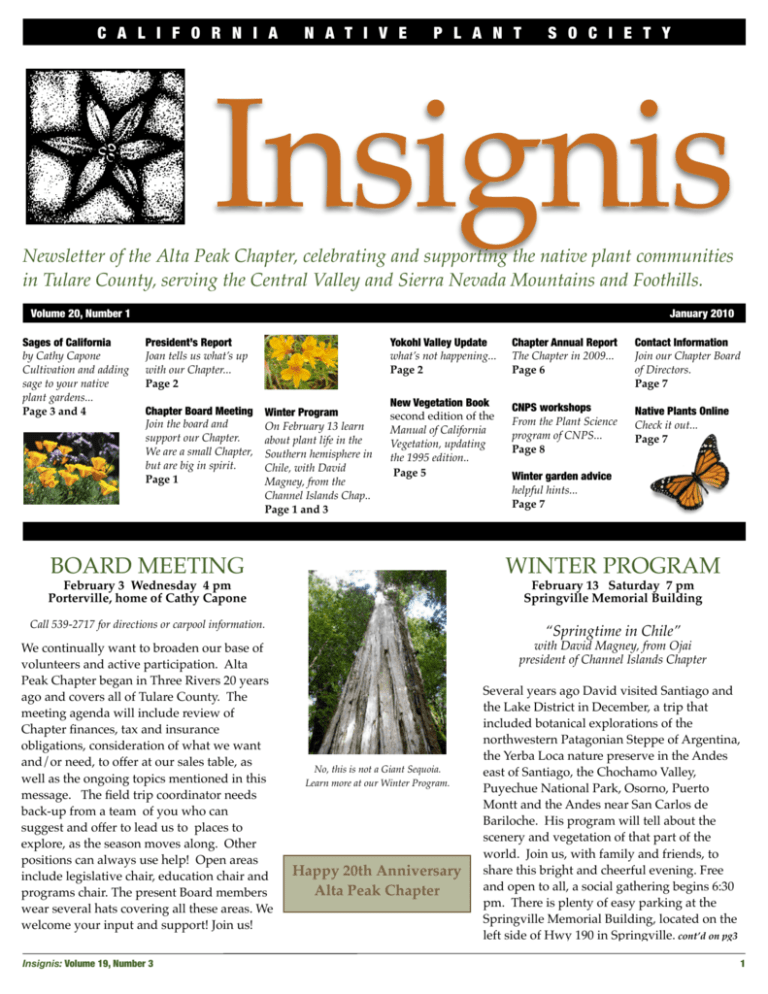January 2010 - Three Rivers, California
advertisement

C A L I F O R N I A N A T I V E P L A N T S O C I E T Y Insignis Newsletter of the Alta Peak Chapter, celebrating and supporting the native plant communities in Tulare County, serving the Central Valley and Sierra Nevada Mountains and Foothills. Volume 20, Number 1" Sages of California by Cathy Capone Cultivation and adding sage to your native plant gardens... Page 3 and 4 January 2010 President’s Report Joan tells us what’s up with our Chapter... Page 2 Chapter Board Meeting Join the board and support our Chapter. We are a small Chapter, but are big in spirit. Page 1 Winter Program On February 13 learn about plant life in the Southern hemisphere in Chile, with David Magney, from the Channel Islands Chap.. Page 1 and 3 Yokohl Valley Update what’s not happening... Page 2 Chapter Annual Report The Chapter in 2009... Page 6 Contact Information Join our Chapter Board of Directors. Page 7 New Vegetation Book second edition of the Manual of California Vegetation, updating the 1995 edition.. Page 5 CNPS workshops From the Plant Science program of CNPS... Page 8 Native Plants Online Check it out... Page 7 BOARD MEETING WINTER PROGRAM February 3 Wednesday 4 pm Porterville, home of Cathy Capone February 13 Saturday 7 pm Springville Memorial Building Call 539-2717 for directions or carpool information. We continually want to broaden our base of volunteers and active participation.! Alta Peak Chapter began in Three Rivers 20 years ago and covers all of Tulare County.! The meeting agenda will include review of Chapter finances, tax and insurance obligations, consideration of what we want and/or need, to offer at our sales table, as well as the ongoing topics mentioned in this message. ! The field trip coordinator needs back-up from a team! of you who can suggest and offer to lead us to! places to explore, as the season moves along.! Other positions can always use help!! Open areas include legislative chair, education chair and programs chair. The present Board members wear several hats covering all these areas. We welcome your input and support! Join us! Insignis: Volume 19, Number 3! Winter garden advice helpful hints... Page 7 “Springtime in Chile” with David Magney, from Ojai president of Channel Islands Chapter No, this is not a Giant Sequoia. Learn more at our Winter Program. Happy 20th Anniversary Alta Peak Chapter Several years ago David visited Santiago and the Lake District in December, a trip that included botanical explorations of the northwestern Patagonian Steppe of Argentina, the Yerba Loca nature preserve in the Andes east of Santiago, the Chochamo Valley, Puyechue National Park, Osorno, Puerto Montt and the Andes near San Carlos de Bariloche.! His program will tell about the scenery and vegetation of that part of the world.! Join us, with family and friends, to share this bright and cheerful evening. Free and open to all, a social gathering begins 6:30 pm. There is plenty of easy parking at the Springville Memorial Building, located on the left side of Hwy 190 in Springville. cont’d on pg3 1 C A L I F O R N I A N A T I Chapter President’s Report by Joan Stewart Looking back to October Plant Sale in Three Rivers with the afternoon Fall Program on same day, same place.! Another part was the full, overflowing room of members and friends to hear Jack Laws’s! talk in the afternoon.! And the absolutely critical part, as always, was the support from all of you who came early, stayed late, on both Friday (set-up) and Saturday, encouraging buyers who often were inexperienced with native plant gardening, and making the day Fun for all of us.! Did you see the front page article and color picture in the Porterville Recorder? ! Too many to list names, you know who you are, and we fervently hope to see you again, next year.! CNPS is, always has been, a grassroots, care about your own backyard, sort of organization, and our local Chapter is whatever we make of it. We continually want to broaden our base of volunteers, active participation.! The Chapter began in Three Rivers, but covers all of Tulare County .! We are scheduling a “Board” meeting on February 3 in Porterville, at Cathy Capone’s home.! Agenda will include review of Chapter finances, tax and insurance obligations, consideration of what we want/need, to offer at our sales table, as well as the ongoing topics mentioned in this message. ! Field Trips coordinator needs back-up from a team! of you who can suggest and offer to lead us to! places to explore, as the season moves along.! Other positions can always use help!! Call Elsah, in Three Rivers, or Joan in Springville, for directions or further information. " The fundamental purpose of CNPS chapters is to work toward meeting the goals of the organization... to “increase understanding and appreciation of California’s native plants and to preserve them and their natural habitats through scientific activities, education, horticulture! and conservation”. ! Conservation/Rare Plants/Vegetation/Legislation projects are not always “fun” tasks, but they are important.! An ongoing area projects that we are involved with is the anticipated! updated County General Plan which will affect the proposed development in Yokohl Valley. A Management Plan for Sequoia National Monument is expected in late February. ! We stand poised, with documented information about potential plant resources that must be considered, to respond when either of these Plans becomes available.! If you want to get involved in either, call me. ! The State Vegetation Program hopes to conduct more surveys in, or close to, Tulare County in coming months, as they work toward developing a state Vegetation Map that is based on field work, actual (“we saw it there”) kind of information.! Interested in helping advise about where the field workers might want to collect data?! Plant associations that are important around here? 2! V E P L A N T S O C I E T Y North to south, across California, the 33 Chapters, in their newsletters, are all remarking on seasonal changes.! Here too, watching leaves on trees along streams, changing color contrasts on chaparral-covered slopes, then the burst of green mingled with last years brown dead grasses, we wonder exactly where are we!! Winter approaches, surely will be with us by the time this Insignis reaches you.! Then we’ll start seeing the first specks of color, white or orange, in lower elevations, and once again wildflower time will be here.! Let us know of special finds...unexpectedly early blossoms, something new along your usual paths, or a trail that lures you into new meadows. " The Annual Report, a required submission to the State Office, reminds us what our chapter does, stands for, in this region, May the coming year be productive and lovely for all of us. ! ! Yokohl Valley Update from the December newsletter of TCCRG Tulare County Citizens for Responsible Growth Why aren’t we seeing any news about the proposed Yokohl Valley Ranch Development? Well, according to the County, there isn’t any news.! Back in March of 2008, the County conducted its required scoping meeting to invite public comments on the Yokohl Ranch Project Notice of Preparation (NOP) of its Draft Environmental Impact Report (DEIR) for the proposed new city of 30,000 people.! The public was given 30 days to comment on the scope and content of the environmental information that should be included in the DEIR.! (Astonishingly, this was announced right in the middle of the public comment period for the draft General Plan Update and its DEIR, with the same deadline for comments.) The County received comments from almost 100 sources (including, needless to say, TCCRG), totaling over 500 pages, on the environmental impacts that would have to be considered in determining whether development of the proposed city should be allowed.! Since then, Boswell Company/Yokohl Ranch Company, LLC has submitted a number of required technical studies on various aspects of the proposed development.! The County has been receiving and reviewing, with its consultants, these studies, but will not allow the public to see them at this time. When the County has all the information required, it will prepare the DEIR for the proposed development and release it for public comment.! Typically! this type of review and preparation process would take perhaps 12-18 months, but the County is, of course, concurrently wrestling the GPU/ DEIR into shape, so it’s obviously going to take longer.! Surely the Yokohl DEIR isn’t going to come out, by some amazing coincidence, once again, during the GPU/DEIR comment period, is it?! Stay tuned. www.tccrg.org Insignis: Volume 20, Number 1 C A L I F O R N I A N A T I V E P L A N T S O C I E T Y WINTER PROGRAM cont’d from page 1 Chile is a long and narrow country on the southwest coast of South America and extends for approximately 2,800 miles (4,500 km) from north to south. ! It is bounded on the west by the Pacific Ocean and on the east by the Andes Mountains and the country of Argentina. ! Much of Chile has a Mediterranean-like climate, with an extremely dry desert in the north (Atacama) and a cold and wet landscape to the south (Tierra del Fuego - Juan Fernandez Archipelago). ! Santiago, the capital, has a climate similar to that of Los Angeles, California. ! The Lake District, near the cities of Valdivia and Puerto Montt, has a climate similar to the Pacific Northwest: lots of rain. Continental Chile is isolated biologically on the north by the Atacama desert, to the east by the Andes, and to the south and west by oceans. ! This area contains diverse vegetation types, including hyperarid desert, summer-dry scrublands (chaparral), the dry cold puna of the high Andes, and temperate rainforest. ! The Chilean flora includes about 5,000 species of vascular plants. ! About 49% of the native species are estimated to be endemic to Chile; this proportion is expected for oceanic islands but unusually high for a continental area. about David Magney He is President of David Magney Environmental Consulting and a Biologist/Botanist/Certified Arborist and Physical Geographer with a thorough knowledge of the flora of California. ! He has over 30 years of field experience in biological studies. ! Mr. Magney has worked on and managed a large variety of projects throughout the Pacific southwest. ! These include biological resource inventories, vegetation mapping and classification, wetland delineations and restoration, rare plant surveys and ecological studies, fisheries habitat assessment and mitigation design, fisheries monitoring, small mammal trapping and surveys, biological impact analysis and mitigation, and construction and mitigation monitoring. ! He has managed and worked on a variety of projects, including energy, residential, commercial, flood control, and landfill projects. ! Mr. Magney has earned a B.A. in Geography and Environmental Studies (emphasis in botany) in 1985 from the University of California, Santa Barbara. ! He also holds an A.S. in Landscape Horticulture and Certificate of Completion in Natural Resources (1975) from Ventura College, Ventura, California. ! He has taught courses or given presentations on wetland impacts and mitigation, CEQA, Clean Water Act permitting, water quality, and wetland delineation methodology. ! Mr. Magney has authored two floras in California and presented numerous papers on vegetation and water quality. ! Insignis: Volume 20, Number 1! 3 C A L I F O R N I A N A T I V E P L A N T S O C I E T Y Sage (salvia) by Cathy Capone, Horticulture Chair and owner of California Natives Nursery in Porterville Sages belong to the mint family a large genus of roughly 900 species that encompasses plant with a wide diversity of sizes shapes, and colors. !Western Garden Guide notes that sages became horticultural stars in the 1980s and 1990s. Botanical gardens and collectors have introduced scores of new species and selections from Mexico, South America, Eurasia and Africa, along with superior forms of our native western sages. What sages have in common is a floral arrangement in which whorls of two –lipped flowers are either distinctly spaced along the flower stalks or so tightly crowded they appear as one dense spike. Several salvia species cross-pollinate freely in the wild and in cultivation, yielding a number of enticing cultivars. Our native sages, without exception, are plants of dry places. Most sages are easy to grow, readily available in nurseries, and serve a multitude of functions in the garden. The genus name Salvia in Latin for “to save” and sages are prized for their culinary and medicinal value. The commercial variety sold for use in cooking is from a Mediterranean species, Salvia officinalis. Native American tribes make teas from sage leaves to help cure illness, and they traditionally toasted and ground the seeds to make a thin gruel. The primary visual attractions of sages are their spectacular floral displays and year round leaf color. !When the other native plants in the garden are resting in late fall and through the winter months until the spring flowers start, the sages give a foundation to the garden. Their solid mass of white through gray to green foliage gives the garden a base of color and form. The blossoms of native species range in color from white to pinkish purple, magenta, and numerous shades of blue. All are magnets for hummingbirds and bees. The drying flowers bear copious seeds that are relished by goldfinches and quails. The stiffly erect seed stalks of some species are lovely in dried flower arrangements. Cultivation: Many sages are potentially long-lived plants that thrive on neglect. Give them plenty of sun (exceptions noted below), reasonably well-drained soils, little to no supplemental water and skip the fertilizer. Too rich a diet will result in excessive growth that causes woody species to fall apart; it also encourages aphid infestations and root rot. Most sages perform best with annual pruning, especially the larger shrubs, for these remove one third of the plant in late fall after blooms have faded. The following are only a partial list of native sages; which have been demonstrated or are likely to do well in Tulare County zones 7, 8 and 9. Jepson lists the following as California native sages, which will grow in zone 7 foothills, zone 8 central valley floor and zone 9 a thermal zone at base of foothills. *Signifies best in this zone Salvia apiana White Sage 7* 8, 9. White sage grows 2 to 3 feet tall and 3 to 6 feet across. In spring it sends up flower stalks that easily add another 2 to 6 feet in height. Flowers are clustered in interrupted spikes, rather than in the distinct whorls characteristic of other sages. Flowers are white with lavender upper lip. The leaves are white to gray and are luminous in the early evening, especially on moonlit nights. Note I have had difficulty growing white sage in zone 9. I will replant placing this sage in light shade and mulching heavily. Salvia clevelandii Cleveland Sage zone 8,9 rounded to 4 feet !gray-green foliage has a marvelous fragrance. Flowers are lavender blue, held in whorls on !tall open spires, May-August. There are many selections, which have compact form or other characteristics. Notably Allen Chickering and Winifred Gillman are compact forms. Salvia columbariae Chia Sage This sage is an annual 10-50 cm in height found in the Sierra Nevada foothills. It’s seeds were ground into flour and used as a staple by Indians in many parts of California. !Chia grows in open sunny places chaparral /oak woodland elevation 500-670 meters. Salvia leucophylla Purple Sage zones 8,9 with moderate irrigation. !Purple Sage is one of the easiest native sages to grow. Despite its misleading common name, this whitish gray shrub produces copious 6 to 10 inch long spikes of light to rosy pink flowers in spring. After petal drop whorls of bracts persist, adding a stiff, decorative element that small birds love to perch on. This semievergreen shrub is quite variable in shape, size, and flower color. Upright forms typically grow 4 to 7 feet tall and are equally wide. Purple sage can be prostrate to 3 feet tall much wider. This sage has two sets of leaves. In the spring it has apple green leaves 1 to 3 inches long they are replaced by smaller silvery white foliage as the weather heats up. Purple sage makes an excellent plant for erosion control. Lightly prune this long-lived species after it flowers to maintain vigor and a pleasing form. There are selected forms such as Point Sal and Figueroa, and Amethyst Bluff. Salvia mellifera Black Sage zones 7* !and 8, 9 with moderate irrigation. !Black Sage is California’s most common sage, occurring in coastal scrub and chaparral plant communities from the San Francisco Bay Area south into northwestern Baja California. !It grows in a prostrate form mounding on itself to reach 2 to 3 feet in height and 1-2 meters in width. The flowers are white to pale blue or lavender rarely pale rose. This sage has a strong medium to dark green color with darker stems. 4! Insignis: Volume 20, Number 1 C A L I F O R N I A N A T I V E P L A N T S O C I E T Y cont’d from pg 4 Salvia sonomensis Creeping sage zone 7* and 8,9 with moderate irrigation and partial shade. Sonomensis is prostrate and mat forming. It grows to 16 inches tall and much wider with hairy leaves. The flowers are lilac to blue and purple in erect clusters. Hybrids of sonomensis and mellifera available such as Dara’s Choice and Mrs. Beard. Salvia spathacea Pitcher Sage zones 7, 8, 9 with moderate irrigation and partial to moderate shade. Pitcher Sage is mat like and rhizomed. Flowers are red to salmon. It occurs in oak woodland, chaparral, coastal-sage scrub. Propagation Propagation from seed is not easy and requires special preparation methods for some sages. Propagation from tip cuttings in the fall using rooting hormone and well-drained sterile soil has yielded rooted cuttings in 80-90% of cuttings within 2 months for Dara’s Choice and Bees Bliss. Other sages such as black sage are noted for self-rooting of branches that lay on the ground. This characteristic makes it likely that rooting of those sages would also succeed. Salvia sonomensis Creeping clevelandii age Sources used in this article: The Jepson Manual James C. Hickman, Seed Propagation of Native California Plants Dara E. Emery, California Native Plants for the Garden Bornstein, Fross, and O’Brien, Sunset Western Garden Book Bernzel ________________________________________________ Request from Cal Natives Nursery for plastic pots, especially one gallon size. I clean and reuse plastic nursery pots. Please drop them off at 806 W. Westfield Ave in Porterville or call me at 559 3619164 to see about other arrangements. from Cathy Capone Salvia clevelandii Cleveland Sage on left Salvia leucophylla Purple Sage on right The New Manual of California Vegetation The long-awaited second edition of the Manual of California Vegetation, written by John O. Sawyer, Todd Keeler-Wolf, and Julie Evens, has just been released. This book replaces the original manual which was published in 1995. Vegetation classification has come a long way since 1995 and this second edition has been widely expanded and advanced. This reference book is of interest to any native plant enthusiast and is an absolute must-have for botanists, consultants, and land use planners. The Manual contains descriptions of over 480 vegetation types. The description for each vegetation type is one to several pages long and contains details about habitat, life history traits, fire characteristics, regional status, and management considerations. There are also maps that show the distribution of each vegetation type across the state. The Manual also contains an excellent introduction that discusses what vegetation is, the history of classification, and the CNPS approach to classification. Insignis: Volume 20, Number 1! 5 C A L I F O R N I A N A T Annual Chapter Report by Joan Stewart Overview:! A quiet year, with two major conservation issues pending, unpredictable spring/summer weather affecting hike schedule, and, well simply a quiet year!!! Last year’s introduction could be repeated--we would welcome new! faces on the ‘Board’; meetings and discussions among officers recently have been more virtual than real. Newsletters, professionally designed and produced by new editor, also Vice President, Elsah Cort, in January, March and September, highlighted the Winter Program,! spring and summer activities, and Plant Sale/Fall Program respectively.. Elsah has also developed and maintains a chapter website at www.altapeakcnps.org.! She solicits! “digital photographs of local native plants, plant communities, native gardens, CNPS events”, and includes “links to native plant related websites, articles and ideas”, as well as chapter newsletter “pdf files... and calendar of chapter events.”! This! opens a window into CNPS that is increasingly important.! Elsah and I attended the January Conservation Conference in Sacramento. Mid-Winter Program,! planned as a distraction from the February cold damp of our foothill/valley region, brought Stephen Ingram to Springville for “Cacti, Agaves and Yuccas of California and Nevada”.! This Saturday evening is always an Occasion for us, with the rental of a large warm central building , open to all, well attended by families,! and preprogram social time a popular gathering for the community. The January newsletter also reported on the previous October Plant Sale, with! appropriate recognition of all those who helped make it the usual success.! Chapter representatives participated in Earth Day activities in the community of Three Rivers in May. ! An early springtime field trip led by Melanie Keeley, restoration horticulturist for Sequoia/Kings Canyon National Parks, took a group through some noteworthy vegetation changes between 1200 and 2500’ elevation near Case Mountain. (personally, I was excited to see Ptelea crenulata, near the southern end of its foothill distribution.) Later field trips, walks were planned to explore high elevation mountain meadows, a distinctive feature of these southern Sierra mountains that generally lack the lakes so characteristic of areas to the north of S/KC Parks; areas covered and affected by glaciers.! A series of these meadow walks were scheduled, then rescheduled, as weather influenced both trail and road access as well as plant growth and flowering. September newsletter focussed on the October Plant Sale, always a major coming-together of members and community interested in use of native plants in gardens. We rely heavily on pre-orders to dictate what we offer, and these pre-sold plants are available to be picked up prior to opening the sale area to the public.! New this year, we offered the Fall Program on the afternoon of the Plant Sale Day, at the same 6! I V E P L A N T S O C I E T Y site.! We were able to bring John Muir (Jack) Laws to Three Rivers for his popular “Finding Connection in Nature” program.! This drew birders, backpackers, as well as those interested in plants, and Laws concluded the talk by speaking of conservation challenges to the Sierra Nevada, pertinent to the CNPS mission/goals. Fall is also the time of year when wildfires are on everyone’s mind....here, there, throughout California.! We made a concerted effort to remind others about reasonable approaches to protection of natural resources as well as homes and property, with suggestions about residential/ commercial landscaping as well as native landscapes, commenting on subdivisions of surface, ladder, and crown fuels. Early October brought the 18th Annual Cal-IPC Symposium to Visalia, the county seat of Tulare County, and we publicized, talked about, and took part in the three days of discussions about developments in wildland weed control as well as restoration theory and practice. In November the Chapter had a booth and native plant information display at the Kaweah Land and Arts Festival, sponsored by the Sequoia Riverlands Trust. Conservation! as in previous year consisted largely in waiting for the revised drafts of environmental documents for both the updated County General Plan and the Management Plan for Giant Sequoia Monument.! Earlier versions of both of these had been considered inadequate, and we are still waiting for the next attempts!! CNPS was, and continues to be,! involved in the meetings and preparation of both; we submitted detailed comments, and follow negotiations and progress.! We are prepared to provide information if, when, pertinent.! These are two huge plans, with far-reaching consequences for the native plants of this part of California.! The central issue for us in the County Plan is whether, or to what extent, new development shall be directed toward existing ‘towns’ or if ‘new towns’ are to be allowed/encouraged.! Many questions concerning where development will be permitted hinge on this larger question.! The Monument Plan attempts to reconcile, balance various recreational uses with interpretation/ education, preservation! of natural resources, and economic constraints. Water? What happens elsewhere in California will affect us here, in! terms of storage, diversion for agriculture, groundwater depletion and wells, all with direct or indirect consequences for natural vegetation from the Valley floor to riparian systems.! So we will wait as all of us do, to see what long-range policies develop from current efforts to anticipate and plan. “We abuse land because we regard it as a commodity belonging to us. When we see land as a community to which we belong, we may begin to use it with love and respect.” Aldo Leopold Insignis: Volume 20, Number 1 C A L Alta Peak Chapter Board of Directors I F O R N I A N A T I V E P L A N T S O C I E T Y Alta Peak Chapter is now on facebook. Just type in Alta Peak Chapter in the search window when you are on facebook. The CNPS State organization is also on facebook. Native Plants on twitter President, Conservation: Joan Stewart 37759 HWY 190 Springville, CA 93265 559-539-2717 tori2toli@ocsnet.net Just go to search.twitter.com and type in the words “native plants” and you will tune into a world-wide conversation about the importance of native plants. People with names like @Earthyman a native plant nursery owner from Iowa, or @nativespring a lover of wildflowers living in the Smokey Mountains in North Carolina, or @InvasiveNotes a tweeter from Maryland who reports on native plant issues all over the world, or @NatlGardenClubs where the National Garden Club organization is talking about the Oregon Garden Club hold its first ever “green” flower show highlighting native plants. Vice-President, Newsletter Editor Elsah Cort PO Box 245 Three Rivers, CA 93271 559-561-4671 elsahc@dishmail.net Other wonderful native plant voices on twitter include: William Wayland, a CNPS member twitter.com/leavesofthree Tree of Life Nursery twitter.com/TOLNativeplants Lorraine, a native plant blogger (mortgage broker by day) twitter.com/sespewoman, blogging about her native plant garden in Simi Vally at www.gardenofnativeplants.com Back to Natives Restoration http://twitter.com/BacktoNatives Tree of Life Nursery twitter.com/TOLNativeplants Elsah Cort, about Sequoia Nat Park and native plants twitter.com/SequoiaNatPark Treasurer, Poster Sales, Plant Sale Membership: Janet Fanning 41118 Blossom Drive Three Rivers, CA 93271 559-561-3461 janetfanning@att.net Outreach: Melanie Keeley 44246 August Drive Three Rivers, CA 93271 559-561-1907 mbkeeley@live.com Horticulture: Cathy Capone 806 W. Westfield Ave Porterville, CA 93257 559-361-9164 ccapone@lycos.com _______________ Chapter Website: www.altapeakcnps.org What does my native garden need during the winter? Helpful hints from Rancho Santa Ana Botanic Gardens www.rsabg.org ANNUALS Sow wildflower seeds of poppies, phacelias, gilias, baby-blue eyes, and tidy tips to brightened up your yard. Add sunflowers, madias, and clarkias to extend the wildflower season into the late spring and summer. OTHER WINTER GARDENING CHORES Transplant Plant your shrubs, trees and perennials during the winter for the best results. Weed It is a good time to weed your garden. Stay on top of the task so that you remove the weeds before they spread new seed. Mulch Although there is debate about the desirability of mulch in native gardens, I find that for most plants it is helpful. Scrub, chaparral and desert plants prefer inorganic mulch, such as pebbles, decomposed granite, or gravel. Woodland plants do well with organic mulch. Keep the mulch away from the stems of the plants where it can contribute to fungal diseases. Prune and pinch For salvias, monkeyflowers and other new plants that are putting on rapid new growth, pinch back the tips to encourage bushier plants. Do not prune or pinch Ceanothus or you will reduce this year’s flowering, rather wait until after they bloom. _______________ Insignis: Volume 20, Number 1! 7 C A L I F O R N I A Alta Peak Chapter Annual Native Plant Sale NEXT FALL October 3, 2010 N A T I V E P L A N T S O C I E T Y CNPS MEMBERSHIP FORM Name: ______________________________________________________ Address: ____________________________________________________ City/Zip:____________________________________________________ Telephone:___________________________________________________ Email (optional):___________________________________________________ Training Program specializes in providing workshops for professional botanists, biologists, and ecologists to teach the skills and provide the tools and resources for conducting sound scientific surveys for rare plants, rare plant communities, vegetation, wetlands, and invasive plants. Discounted registration fees are offered to CNPS members. http://cnps.org/cnps/education/workshops Mail with check to CNPS, 2707 K St., Suite 1, Sacramento, CA 95816, or you can join or renew automatically year after year via the website www.cnps.org and click on JOIN. Insignis: Volume 20, Number 1 CNPS Workshops: The Plant Science I wish to affiliate with: ____ Alta Peak Chapter Other Chapter ____________________ Membership Category: ____ Student/Retired/Low income, $25 ____ Individual, $45 ____ Family/Group/Library, $75 ____ Plant Lover, $100 ____ Patron, $300 ____ Benefactor, $600 ____ Mariposa Lily, $1500 Elsah Cort, Editor PO Box 245 Three Rivers, CA 93271 Three Rivers Arts Center North Fork Drive in Three Rivers





